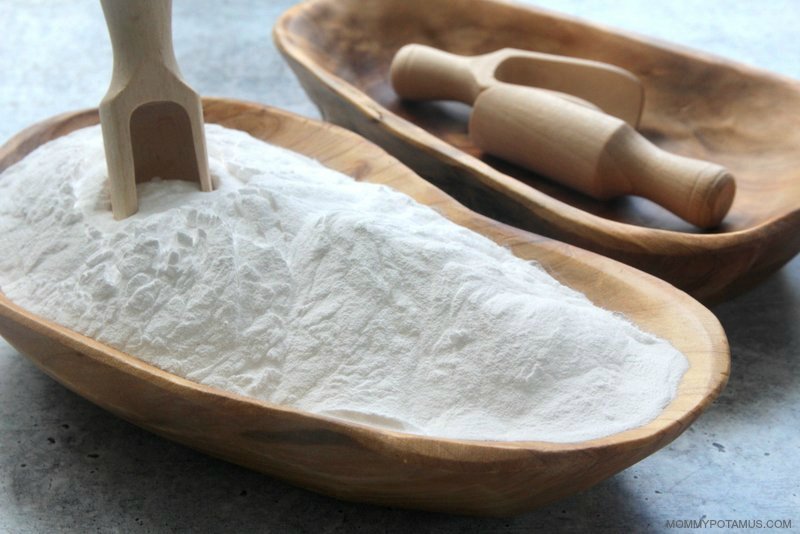
I’ve been using my 3-ingredient homemade laundry detergent recipe for years now and am so happy with it – it’s affordable, easy to make, and if you read the comments you’ll see that it really gets clothes clean.
Part of the trifecta blend is washing soda, which can be used throughout the home as a cleanser, degreaser, deodorizer, build-up remover, and water softener.
I can usually pick it up in the laundry aisle at my local grocery store, but sometimes they run out . . . usually when I am behind on laundry, too. Also, a lot of you have reached out because you can’t find it locally, or you can only buy the kind sold in big plastic buckets instead of the brand that comes in eco-friendly recycled cardboard and want a better option.
With that in mind, I’m going to show you a super easy method for making washing soda from baking soda.
So, what is washing soda?
Washing soda has been used for a long time to clean laundry and around the house. It’s rich in sodium and can be made from the ashes of seaweed, kelp and other vegetation, though these days it’s usually derived from limestone.
I promise not to dive too deep into this part, but from a chemistry standpoint it’s very similar to baking soda:
Washing soda (sodium carbonate) = Na2CO3 (2 sodium, 1 carbon, and 3 oxygen molecules)
Baking soda (sodium bicarbonate) = NaCHO3 (1 sodium, 1 hydrogen, 1 carbon, and 3 oxygen molecules)
How does a few extra molecules affect cleaning power?
It all comes down to pH.
Baking soda has a weaker (more neutral) pH, which makes it less effective for some types of cleaning. Washing soda, on the other hand, has a higher pH, which can boost cleaning power in many situations.
Fortunately, when baking soda is heated to a certain temperature, it releases those extra carbon dioxide/water molecules and becomes washing soda. We’ll dive into a super simple method soon, but first you might be wondering if there’s much you can actually do with it.
Yes, yes there is . . .
5 Ways To Use Washing Soda
Once you have a batch of this stuff, you can put it to work in your laundry room, kitchen and bathrooms. Here are some of my favorite tried-and-true ways to use it:
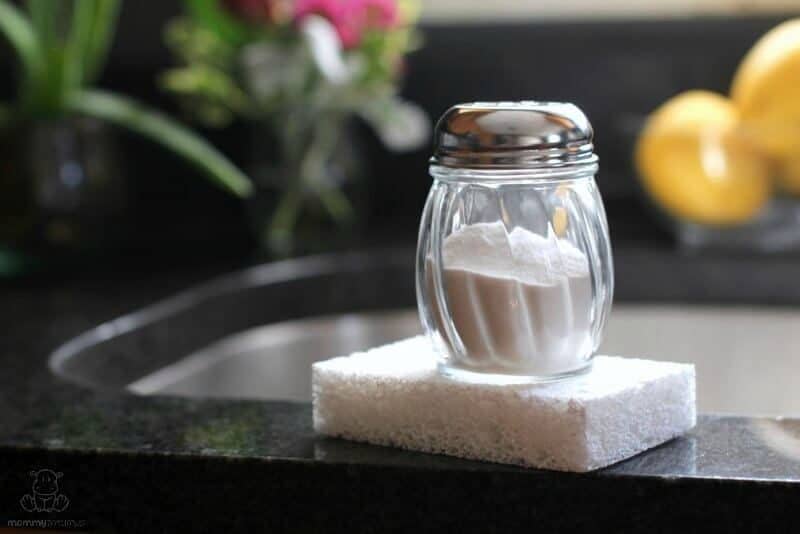
1. Scouring Powder
When when the Environmental Working Group analyzed one of the most popular scouring powders on the market, they found that it:
“emitted 146 different chemicals, including some that have been linked to cancer, asthma and reproductive disorders. The most toxic chemicals detected – formaldehyde, benzene, chloroform and toluene – are not listed on the label.” (1)
Skip it and make your own instead with this super quick and easy recipe.
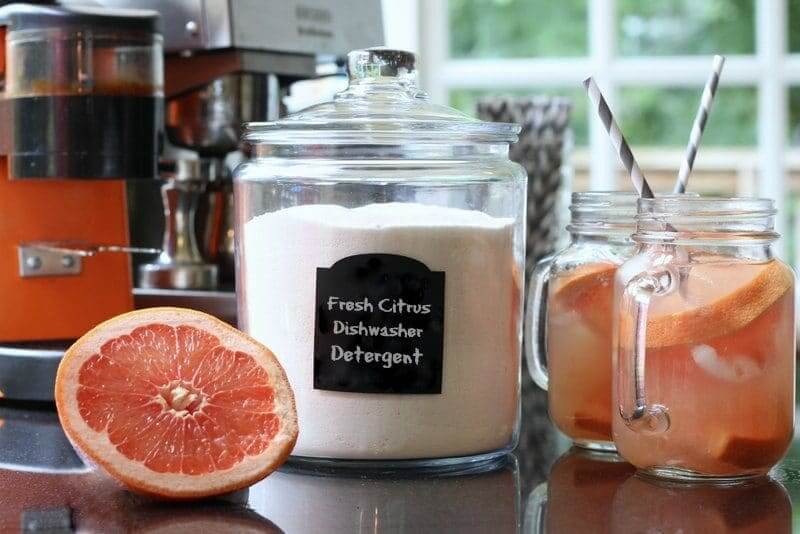
2. Dishwasher Detergent
If you’ve ever tried making homemade dishwasher detergent and been disappointed with the results, chances are you were closer to a great recipe than you thought!
Most DIY formulas use the same basic ingredients, but there’s a trick to getting them to work. Details + my super simple recipe can be found here.
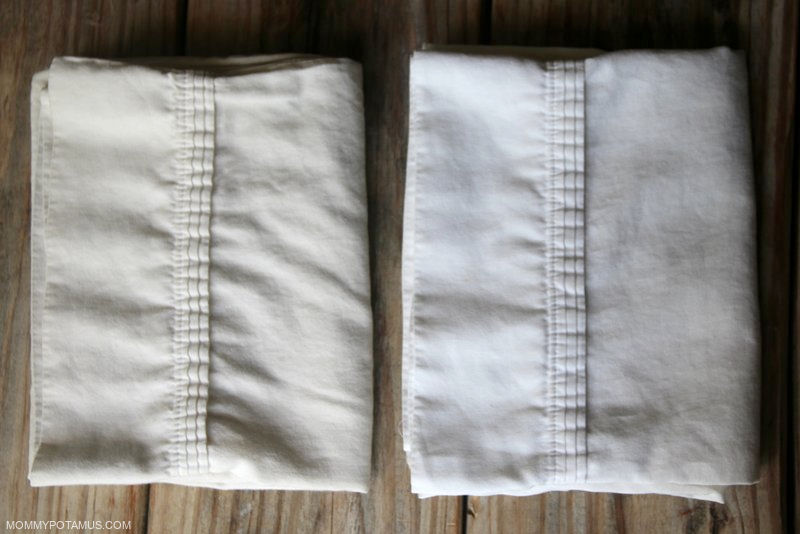
3. Homemade Bleach Alternative
When combined together, hot water, washing soda, hydrogen peroxide and lemon essential oil naturally whiten and brighten laundry. Here’s my method.

4. Deep Clean Your Washing Machine
I used to think that washing machines were self-cleaning: Just toss in your dirty clothes, a scoop or two of laundry detergent, and the machine cleans the clothes AND itself, right?
Unfortunately, no.
Both top-loaders and front-loaders can develop buildup from soap scum and hard-water deposits, and they’re vulnerable to mold and mildew, too. Here’s how – and how often – to clean your machine with washing soda and a few other ingredients.
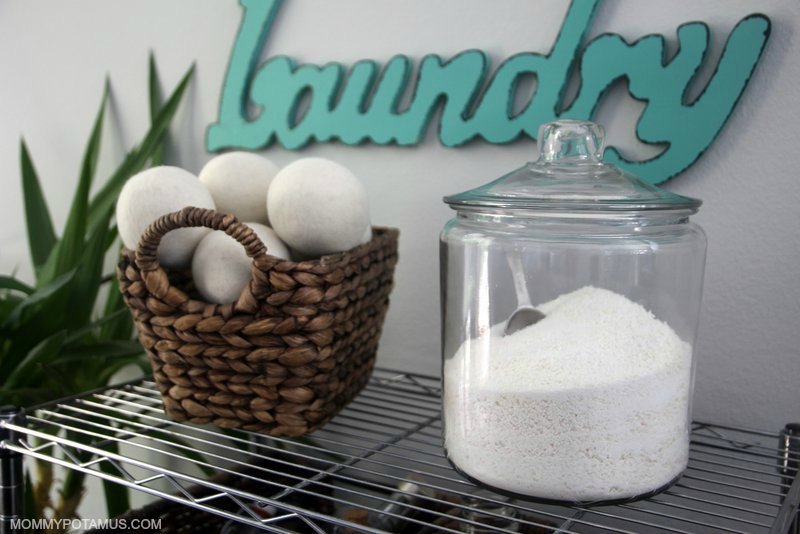
5. Homemade Laundry Detergent
Washing soda competes with magnesium and calcium ions in hard water, which prevents the magnesium and calcium from bonding with laundry soap/detergent and rendering it ineffective.
If you’ve ever searched around for laundry detergent recipes online, you’ve probably seen ones that have five, six or even seven ingredients. It may seem like they’d be more effective than ones with just two or three, but simplicity really does work in our favor here. Here’s how to make laundry detergent with just a few ingredients.
What To Buy If You Don’t Want To DIY
Both Arm & Hammer’s Super Washing Soda and this 100% pure washing soda here are good options.
How To Make Washing Soda From Baking Soda
Although it’s not actually alchemy, making washing soda is super easy and feels kind of magical to me. I usually start a batch just after dinner while my oven is still warm from cooking.
You’ll Need
- Baking soda
- Large baking dish or cookie sheet with a lip around the outside
- Heat-proof spoon or spatula
Step-By-Step Instructions
Step 1: Preheat your oven to 425-450F.
Step2: Spread 2-3 cups of baking across a large baking dish or baking sheet.
Step 3: Bake for about an hour, stirring well at least once around the halfway mark. The baking soda needs to reach 400F in order to convert to washing soda, so the exact amount of time needed will vary based on whether your oven runs hot or cold, and how thick the baking soda layer is in your pan.
You’ll know it’s ready by its visual texture. Baking soda is light and fluffy, while washing soda is flat and grainy. In the photo below, washing soda is on the left and baking soda is on the right.
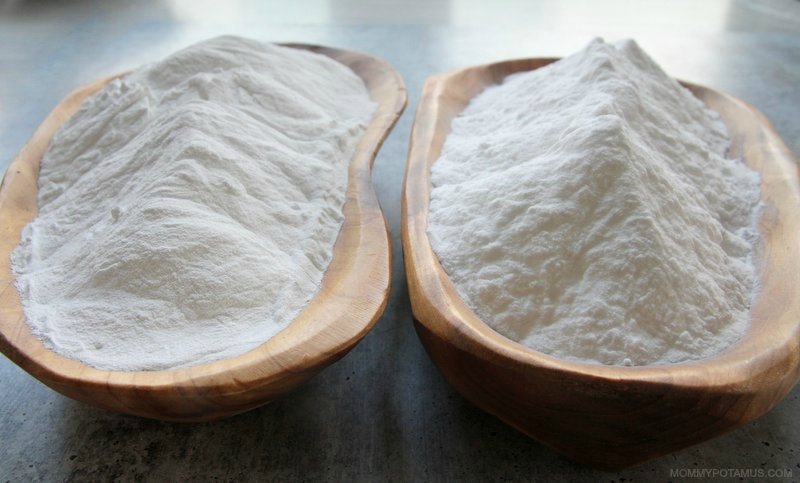
It may be helpful to compare your washing soda with baking soda to see the difference until you get a feel for how long the conversion takes with your oven.
Store your homemade washing soda in an airtight container.
More DIY Cleaning Recipes To Try
Homemade Stain Remover – I’ve used this stain remover on ketchup, grass stains, oil stains, and those mystery stains you don’t notice until something has already been washed and dried.
There are before and after photos in the post, and I’ve listed two non-toxic options you can buy if you don’t want to DIY.
Vinegar + Hydrogen Peroxide All-Purpose Cleaner – Non-toxic and affordable, hydrogen peroxide is classified by the CDC as “a stable and effective disinfectant” for hard surfaces. When used in tandem (but not mixed with) vinegar it becomes part of a dynamic duo that food scientist Susan Sumner described this way:
If the acetic acid [active component of vinegar] got rid of 100 organisms, the hydrogen peroxide would get rid of 10,000, and the two together would get rid of 100,000” The method in this article was pioneered by Sumner while she was working at the University of Nebraska.
Want a FREE ebook of non-toxic cleaning recipes that WORK?
I’ve created a free ebook for you as a gift for signing up for my newsletter. 7 Non-Toxic Cleaning Recipes That Really Work covers seven recipes that you can make in just a few minutes each for squeaky clean windows, sparkling dinnerware, lemon-fresh countertops, and more. Subscribe to my newsletter below and you’ll be redirected to a download page for immediate access to this PDF ebook.
How To Make Washing Soda From Baking Soda
Equipment
- Large baking dish or cookie sheet with a lip around the outside
Ingredients
- 2-3 cups baking soda
Instructions
- Preheat your oven to 425-450F.
- Spread 2-3 cups of baking across a large baking dish or baking sheet.
- Bake for about an hour, stirring well at least once around the halfway mark. The baking soda needs to reach 400F in order to convert to washing soda, so the exact amount of time needed will vary based on whether your oven runs hot or cold, and how thick the baking soda layer is in your pan. Remove from oven when ready (see notes section for how to tell) and allow to cool before storing in an airtight container.
Notes
How To Know Your Washing Soda Is Ready
You’ll know your washing soda is ready by its visual texture. Baking soda is light and fluffy, while washing soda is flat and grainy. In the photo above, washing soda is on the left and baking soda is on the right. It may be helpful to compare your washing soda with baking soda to see the difference until you get a feel for how long the conversion takes with your oven.Sources

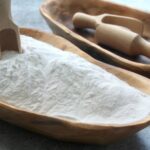
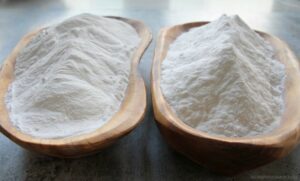
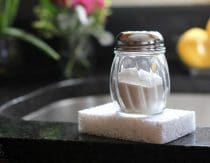
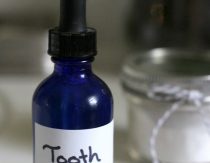
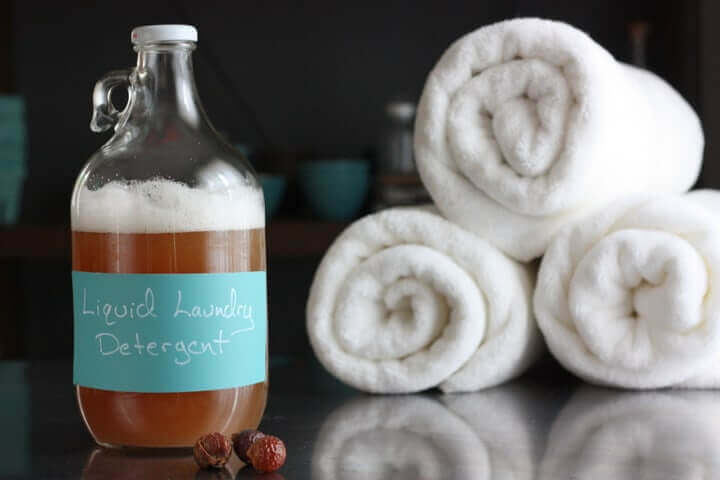

How much washing soda is used? Do I add this with my normal detergent before putting in laundry or after? Is it okay to use it in all types of laundry? Will the washing soda dissolve or should I worry about a build up in the drain over time? Thanks for your answers.
Hi Mirian, I incorporate washing soda into my homemade laundry soap. You can find details on the amount I use here: https://mommypotamus.com/homemade-natural-laundry-detergent-made-easy/
I’ve found that it dissolves best in warm water, so even when I’m running a cold wash I start off by selecting warm, then I add in a little laundry soap and give it a swish in the water with my hand, then turn my settings to cold and add clothes.
I use it with all types of laundry including cloth diapers. It is considered septic safe and I have never had an issue with buildup at all. Hope that helps!
great to know! have a large 10 lb bag of soda – used for drain cleansing, but his might work faster or better!
will this washing soda be safe for colored clothing or simply whites?
I’ve used it in my laundry detergent recipe for all types of clothing (colors and whites) for many years 🙂
Yes, I have the same questions. Currently, I am using white distilled vinegar in my wash in place of bleach and fabric softener. Can this be used as a substitute or in conjunction with the vinegar? If so, how much should I use per load? Thanks for all the helpful tips!
Can washing soda be used when washing knits or delicates?
Wow, this is awesome! I use washing soda in my dishwater, it means I can use a lot less detergent or soap, it cuts the grease incredibly well. Then I use vinegar in my rinse water and my dishes are squeaky and sparkling, with very little soap or detergent needed. I buy pure washing soda from the supermarket but it’s more expensive than the bicarb that I buy in bulk, so this is great! thanks again Mommypotamus!
Great
If I put the baking soda in the oven with other food that I’m also cooking, will that ruin the washing soda and make it smelly when I clean with it?
Well I did finally make my own laundry soap, so this is good to know too. Thank you.
I too use washing soda in my homemade detergent. I did know that you could make baking soda into washing soda, but I didn’t know the exact temperatures or times, so this is very helpful! I much prefer to only have to buy a huge bag of baking soda, and create my own washing soda from there. (part of the reason being that I can only find washing soda at Walmart, and I avoid that store like the plague!! ) Now I can just buy my baking soda from Costco, and not have to step foot in Walmart!! Thanks, Heather!
Excuse my ignorant question, but i wonder now what is wrong with adding borax? I thought it was natural and safe to use … Thank you
In reference to Maria’s question- I started adding borax to my wash a while back because I had heard that it helps with hard water. We have very hard water where I live! Unfortunately, it faded my darks so I had to stop using it. I haven’t heard of washing soda…so thanks for the info…it seem like washing soda helps with hard water… I think?? Please verify
Borax only “activates” in warm/hot water. So if you wash in cold water, it’s pretty much useless.
You are 100% right you need to wash your cloths in warm/hot water that is why I do not use borax in my laundry soap because I mainly was using cold. I use baking soda, washing soda and use only 5 drops of sweet orange essential oil. My husbands work cloths come out clean and odor free!! I wash his work cloths in warm/cold.
Lisa,
Do you just use washing soda and baking soda along with the essential oils as your laundry soap?
I am so glad to hear that Arm&Hammer’s Washing Soda is safe to use! I use it in my laundry and I also make a great All-Purpose spray cleaner with it. Big sigh of relief here! Thanks for the great info.
I read that arm & hammer tests on animals
I believe that companies should test their products on their CEOs and board of directors, not on animals.
lol…lol
this is good for their suggestion boXes ; )
That is a perfectly sound and reasonable suggestion! How the FDA could base their regulations for human-use (every-things) by tests conducted on the biology of animals is irony at the least & at the most ludicrous!
Hi Heather, I could not find the information about how much washing soda per load. I assume 1-2 tablespoons?
And to clarify other thing 🙂 When I use your homemade washing detergent + washing soda. Then there is in the mashine together – soap, soda and washing soda? + vinegar for rinsing cycle?
And lemon essential oil (5 drops) I add together with washing detergent?
Thanks!
Mari
Walmart sells washing soda for $3 a box, I combine one box to one box borax. One coffee scoop (which I think is 1/8th cup) to an extra large load of laundry washed in cold water gets out the ground in mud on my husbands jeans . I love this recipe, there’s not any undissolved soap chunks, which I found to be a problem with the grated bar soap recipe. And it’s about $7 for two months of detergent for a family of five. I use Goop Hand Cleaner for food oil or gease spots, it is also sold at Walmart in the automotive section and is cheap.
Does anyone have a homemade recipe for a safe, non toxic, hair spray? Thanks
I use sugar water. I boil water and then add some sugar to it and let it dissolve. It works great.
Bet the bees follow you everywhere. LOL
Hi Claudia…I like the idea of your homemade hairspray! Would you consider sharing the ratio of water and sugar used in your hairspray? This is an answer to prayer because the odours of bought hairspray really mess up my breathing. Thanks?
Wasteland rebel.com . has a 2 ingredient Zero waste “recipe”for hair spray.
Can you overcook the baking soda? I think i may have overcooked it and it has just turned back into powder more so than sand. Is that what would happen if I overcooked it?
Baking soda converts to washing soda when it reaches about 400ºF (200ºC), so the amount of time it takes would depend on the amount being converted, as well as how thickly it’s laid out on the baking sheet/pan. If it’s a large amount piled up rather thickly, then it may help speed things along by giving it a stir occasionally. That would also help to ensure it’s not only certain areas which are most exposed to heat that get converted while other, less exposed parts, remain as baking soda if it’s removed from the oven too soon before all of it’s able to reach the correct temperature and complete the conversion process.
Then, when it’s done, the resulting washing soda’s not actually sand-like, but when compared the baking soda’s lighter weight and smoother in texture, whereas the washing soda’s heavier and a bit more granular… even so, the washing soda’s still quite fine in texture (nothing like sand) and requires fairly close inspection, while comparing side by side, to differentiate and notice an appreciable difference between the two. I also found bright lighting helped when I wasn’t as familiar with the difference… since after shining a LED flashlight on them I could then see the washing soda’s granular texture more clearly pronounced by the contrast in the shadows produced by the bright lighting. If you rub a bit of baking soda between your fingers, and then rub a bit of washing soda to compare, the washing soda is a little grittier, but it’s not a huge difference like comparing icing sugar to sand or raw cane sugar.
And in answer to this question, nothing should actually happen by heating it for too long, because after the baking soda has converted to washing soda, it’s extremely stable since sodium carbonate doesn’t even start to decompose until it reaches a VERY high temperature, 400°C (752°F), which household ovens can’t even reach! And in case anyone’s curious, the next stage after that is when it melts, which doesn’t happen until it’s heated to 850°C (1560°F)! Only a kiln can reach temperatures high enough for washing soda to change into another form. So theoretically speaking, it can be baked indefinitely in a regular oven and still remain as washing soda.
Do note though, that by that same principle, because conversion from baking soda to washing soda can only be achieved after the required temperature’s been reached, around 400ºF, then in the case of using an oven that’s set to bake at exactly 400ºF but in actuality runs colder than it should, then if it never truly reaches 400ºF and only ever *really* reaches, for example, 380ºF then once again, theoretically speaking, it could continuously bake until the cows come home and would still only be just baking soda, as it wouldn’t have ever gotten the chance to turn into washing soda at any point. Although a part of the process does start at 210ºF (100ºC), which is when baking soda begins to release carbon dioxide and water, it can’t technically complete that chemical process into another form without ever reaching the correct temperature for that to happen, no matter how long it’s held for at just below the magic temperature required for transformation. Which is why this article recommends 400º-450ºF, but now that I know further decomposition or burning isn’t a risk at normal oven temperatures, then to avoid endlessly baking without success, I’d set the oven for 425ºF (220ºC) as a minimum to ensure that absolute conversion is reached.
Can I use baking powder instead of baking soda. It’s really hard to find baking soda
(Bicarbonate of soda) in bulk where I live.
Unfortunately, baking powder has additional ingredients that would change the composition of the final product.
Purchase baking soda online, it will be delivered to your front door.
Try a feed center like ShurGain, Agway, Cargill, or any other grain mills in your area. Cows need it so they carry it in 50 lb. bags.
hi
i have sodium percarbonate 2Na2CO3·3H2O2
can you tell me how to make sodium carbonate from it ?
thank you
Sodium percarbonate contains hydrogen peroxide, DO NOT heat it in an oven. It is fine to use it as it is, see: http://www.chemistrystore.com/sodium_percarbonate2.pdf
I hope this isn’t a *DUH* question, but is it possible to do this in the microwave?
NO!
Hi Mommypotamus! I am new to homemade laundry alternatives but would like to get started. I am confused why you need to convert the baking soda into washing soda. The Arm & Hammer baking soda packaging says you can add it directly to your laundry. Can you please help clarify? Thanks!
When converted it has more cleaning power 🙂
Thanks for your reply! ?
What if I just use baking soda with essential oils? I want to save energy. I’m hoping that if our dishes are moderately pre-rinsed before that this would be ok?
This is awesome and looks so easy, thanks for sharing! I will reference this with an article I am doing on homemade dishwashing detergent!
Hello mommypotomus! I’m a big fan of your site!
Can I make washing soda with a conventional oven and for how long should I bake it?
My autocorrect sucks! I meant convect oven!
I would like to know if I could use my convect oven so I spend less time baking it. Thanks!
Thanks so much! I was in a panic because I couldn’t find washing soda to make my powdered laundry soap and you saved me! The recipe for my laundry soap is on my blog.
Do you know if this is safe for pets? I was reading of a way to power wash the driveway without a power washer and bleach, (using washing soda) but my pets like the lay in the shady parts of the driveway when it’s hot. I’ll obviously rinse it, but not sure I’ll get it all off. It could get on my pet’s fur when hanging out.
Yes, safe for pets. In fact washing soda (sodium carbonate) is used in some homemade food preparations (ramen, bagels). For homemade ramen it’s put in the water to boil the noodles and it makes them springy and curly. Note this is just the water to boil the noodles — you wouldn’t want to put sodium carbonate in the final soup because although it would be safe, it would taste very soapy!
In one of your comments it says that you dissolve it in warm water and swish it around before switching the washer to cold water. I’m getting a new front load washer so I don’t think that’ll be possible to do. Is it critical that I do that? Should I dissolve it in a cup of warm water and add it to the dispenser that way or do you think it would be ok if I didn’t dissolve it first? Thank you!
I did a great deal of research last year on animal testing. Church & Dwight (makers of Arm & Hammer) conduct and condone horrific, unnecessary animal testing! So regardless of whether or not their washing soda contains optical brighteners, I still wouldn’t use it “worry free”.
Using organic, environmentally-friendly products is more than just about me, I consider everyone and everything on the planet. As I’m sure many people do.
Bob’s Red Mill is a good baking soda to buy! I’m looking forward to trying this laundry soap recipe!
Yes! I stopped buying arm & hammer and am only using Bob’so! For about a year now!
I too am conscious of the horrors animals go through when chemicals are tested on their delicate skin and EYES. These animals are tortured and then killed when the tests are over, all so we don’t sue the company bcz the chemicals burn our eyes. The answer… stop using unnatural chemicals, and don’t make companies wealthy that test on animals.
Would arm & hammer laundry detergent that already has oxi clean in it be just as efficient…?
Thank you
I learnt a lot from this post and the comments, thanks a lot!
Does anyone know if will remove oil based cologne from clothing, bedding, etc.? My father in law puts it on his HANDS and everything he touches turns into gold right! He wants to come visit again and last time that stuff stuck to my washer and dryer. I feel so overwhelmed 🙁
I would try baking soda and vinegar to remove oil and smells. Vinegar also softens towels and sheets naturally. I use 1/4 cup baking soda and a little less than 1/4 cup vinegar in a medium load.
Can any one help me how to make detergent, so that can be used in washing machine n got confused with many article.give me best one who is happy to use it,what r it’s ingredient, highly obliged for the sharing
People!
If all of you stopped buying baking soda manufactured by companies who continue to conduct and condone animal testing, I bet they’d listen. Who of you had heard of parabens five, ten years ago? It has to start with us.
consider it done, Kat. People, we must all step up to the plate. Knowing that Arm & Hammer tests on animals had me immediately put the kibosh on ever purchasing it again. Thanks for getting the word out.
Does anyone know if expired baking soda will still turn into effective washing soda?
How long will the homemade washing soda last once I’ve baked it? Do you recommend storing at a certain temp or in a certain container until I use it all?
Thanks for all the info! I was wondering if anybody ever tried dehydrating lemon rinds and then grinding them up into a powder and adding them for extra cleaning power?
This sounds like it would be great but also sounds like a lot of work. I don’t have a dehydrator or food processor either. I would throw the lemon rinds right into the washer without doing any of that. Lemon is a powerful cleaning agent. I’ll try that next time. Thanks for the idea.
I saw another similar natural DIY products-type of blog in which a woman dehydrated organic lemon peels and listed about 10 or so uses for them in various home cleaning and food recipes. I may have that link bookmarked, but I’m not sure if that would be considered disrespectful or a conflict of interest to link another person’s blog page here without expressed permission… but you could try googling “how to dry and use lemon peel brownthumbmama” to find it…
(sorry Mommypotamus, I hope it was ok to mention how to find it, as I’d think it’s a good thing to share knowledge and learn from each other, however please delete if this is an issue! Thanks!)
Any tips on storage?
hmm, what world are people living in when the say things like “buy ecological, it’s cheaper. Be a vegan, it’s cheaper, be a vegetarian, it’s cheaper. Make home made detergents, it’s cheaper…”
Certainly it’s never cheaper to do things yourself. Here in sweden you can buy 800ml of liquid detergent for about 2 dollars. that’s 25 wash!
Hi Mommypotamus! Thank you for your fab site!! When you talk about dissolving the washing soda with a swish in hot water I’m a little confused. I am currently trying to dissolve my washing soda (Arm & Hammer) to make a homemade laundry soap and it absolutely will NOT dissolve. So I put it in my Vitamix and I’ve mixed it with hot water for about 3 or 4 minutes on top speed and every time I stop it just resettles. It is driving me crazy. This stuff does NOT dissolve! The same thing happened the last time I made this recipe. I just gave up after awhile and shook it good before each use. Am I doing something wrong???
Is this safe on colours? My son has baseball white pants with a blue pinstripe and I want to see how white I can get them again.
I’ve never had an issue with it fading colors.
Soda ash is another name for washing soda (aka sodium carbonate). Yes, you can convert baking soda (sodium bicarbonate) into washing soda by heating it.
Oh wow this so nice and i love this.thank you so much for sharing your information.
Love this article! I make CP soap and M wondering if I can add washing soda to a CP recipe to use for hand washing dishes?? How much per pound of oils would you think??
It might be possible but I haven’t experimented with it. If you do please let us know how it turns out!
Hi – don’t want to be the fussy one but….
Sodium bicarbonate (also known as sodium hydrogen carbonate) is NaHCO3
Sodium carbonate is Na2CO3
Can we get the chemistry right please
Don’t downplay the usefulness of those plastic tubs: they can be used to store food long term after thorough washing. They can also be used to store other items and are usually stackable up to about 3. I purchase my washing soda this way after years of the cardboard boxes. It is a huge savings, as I use washing soda for laundry and also for my small dishwasher.
I have used many laundry recipes over the years, and have come up with one I love AND it is SO much simpler than others: Using the blue scoop that comes out of the oxyclean tubs, add three to your washer that is filling with WARM water. I then add about 1-2 TBSP of liquid soap, like bronners or other less expensive brands. That’s it. The washing soda alone would probably do the trick, but I live in the country and feel the need for a few suds. I ALWAYS use warm, as in the winter with a well, the water is MUCH too cold and takes forever to fill the machine. Plus it takes warm to dissolve the washing soda.
For my dish ‘detergent’, I fill the closeable cup with citric acid, put about 3TBSP of washing soda onto the door, and a VERY small amount of liquid soap, (for grease cutting)squirted onto the washing soda, PLEASE be careful! Using too much can cause flooding of the suds onto your floor! [ask me how I know]and a few squirts of hydrogen peroxide onto the floor of the dishwasher. If I have been sick, or are cleaning pet dishes, I also add a dropper full of my homemade thieves blend.
I’m very into easy and these two recipes work well for me.
BUT having the ability to make washing soda from baking soda is a great idea.
AND I also purchase it in the 5 gallon tubs, which I then clean and reuse for many things.
good website. necessary information to help stop all the toxic products being pushed on us
So glad you are doing what you do! Thank you!
Heather,
I love your website, I am a 20-year-old product design student that’s moving out next month and I want to wash my clothes with the least harmful washing detergent possible. We need to start being accountable for the products we use every day and in doing so I find your website extremely useful. You have done beautiful research and have laid out everything you have found and done yourself in a super thorough way. I just found out about this website, but will definitely be back. We need more websites like this that do good research and share it with the world!
I am so glad to find your website and to learn how to make DIY cleaning aids.
I have a set of sheets that hold an odor so I can’t use them. Do you have a solution to fix this?? I have tried everything that I can think of. Thank you!
Dee
Excellent!
Thanks!
Tide says that it works better in cold water than warm or hot. I wash everything in cold water.